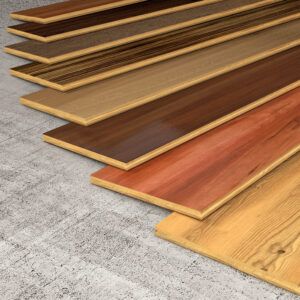
The problem with DIY hardwood floor installation is the fact that it’s not as simple as it often seems, and there are some common mistakes that can lead to major consequences.
Many people consider the option of DIY hardwood floor installation. They have heard that it’s easy, and pretty much anyone can do it—just unload the panels and lay them out onto your subfloor. Unfortunately, there’s a lot more to hardwood floor installation than many people know. Without the proper knowledge, experience, and tools, your DIY hardwood floor installation could turn into a costly disaster.
Acclimation
Did you know that the wood panels for your wood floors need to be acclimated? This isn’t really common knowledge for many people, but it’s true. Wood expands and contracts as it is exposed to various amounts of humidity. Due to this, wood needs to be acclimatized to the home before it is installed. If this step is skipped, it could result in ill-fitting floors, as the panels will acclimatize after installation. This could result in floors that just don’t look right, but in a worst-case scenario, it could potentially cause damage to any fixed objects, including walls.
Expansion Joints
I know what you’re thinking—expansion what now? Even after the wood has acclimated to your home, the flooring will still expand and contract as humidity fluctuates. Expansion joints are important to allow this movement without it becoming a problem for the floor or any fixed objects around it. That’s not the only caveat—engineered hardwood and solid hardwood require varying degrees of permitted expansion, and each wood species needs to be tailored to its own needs.
Securing Methods
Hardwood floors require nails or staples to keep everything in place and limit movement. These need to be carefully and evenly spaced, which isn’t always as easy as it sounds. For anyone with a concrete subfloor, gluing is considered the best option for securing your hardwood floor panels. Failure to secure your boards properly can result in excess movement and lippage, which results in a floor that doesn’t live up to your standards.
The Solution
It’s understandable that people want to attempt to DIY their hardwood floor installation in an effort to save money. The problem with this is that there’s a good chance it won’t. It’s very easy to make a mistake that results in significant issues or damage, and this will require you to purchase more flooring, and you’ll probably need to hire a professional installation team to install it the second time around. You may also have to pay to fix any damage to your home that may have occurred.
Hardwood Flooring from Jason Brown Wood Floors
At Jason Brown Wood Floors, our commitment to quality installation is clear in all that we do, which is why our customers consistently rate us as one of the top contractors in the region. We have been awarded Baltimore Magazine’s Best of Baltimore Award 4 times and have been proudly serving the Baltimore Area for over 16 years. If you’re ready to speak with someone about your hardwood flooring project, we want to hear from you! Contact us at 410-668-9131 or send us a message here.
Jason Brown Wood Floors is also your convenient dealer of high-quality, professional-grade power tools. We offer brands that tradespeople trust most for the job. Come check out our Abingdon showroom to browse the in-stock selection of products and tools by Festool, Freud, Diablo, Shaper, Mirka, Makita, Saw Stop, and Grex.
Keep up with us on Facebook, Twitter, Pinterest, Houzz, and YouTube, and check out our blog for more news and information!


